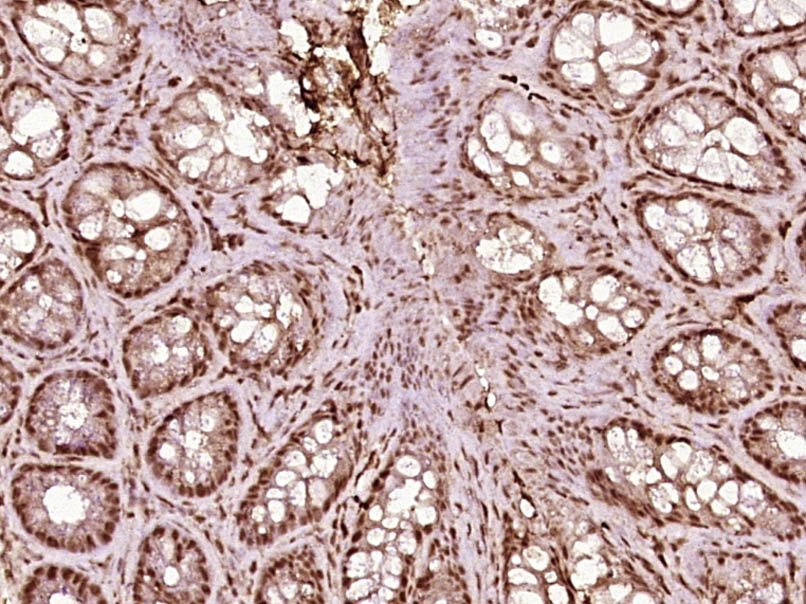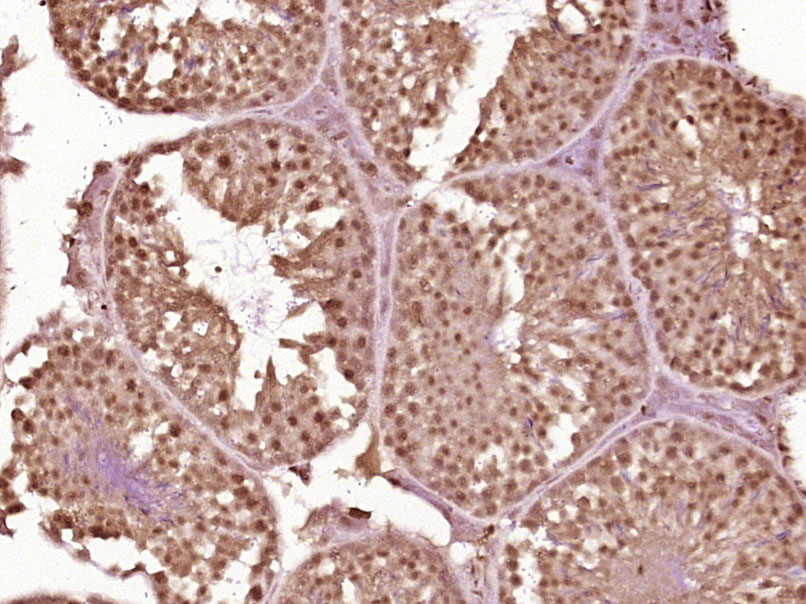
Rabbit Anti-PSMC3IP antibody
26S protease regulatory subunit 6A; 26S proteasome AAA-ATPase subunit RPT5; Human immunodeficiency virus tat transactivator binding protein 1; MGC8487; Proteasome (prosome macropain) 26S subunit ATPase 3; Proteasome 26S ATPase subunit 3; Proteasome 26S su
View History [Clear]
Details
Product Name PSMC3IP Chinese Name 蛋白酶体26S亚基ATP酶3相互作用蛋白抗体 Alias 26S protease regulatory subunit 6A; 26S proteasome AAA-ATPase subunit RPT5; Human immunodeficiency virus tat transactivator binding protein 1; MGC8487; Proteasome (prosome macropain) 26S subunit ATPase 3; Proteasome 26S ATPase subunit 3; Proteasome 26S subunit ATPase 3; Proteasome subunit P50; PRS6A_HUMAN; PSMC 3; PSMC3; Tat binding protein 1; TAT-binding protein 1; TBP-1; TBP1. Research Area Cell biology transcriptional regulatory factor Ubiquitin Immunogen Species Rabbit Clonality Polyclonal React Species Mouse, (predicted: Human, Rat, Dog, Horse, Rabbit, ) Applications ELISA=1:5000-10000 IHC-P=1:100-500 IHC-F=1:100-500 ICC=1:100-500 IF=1:100-500 (Paraffin sections need antigen repair)
not yet tested in other applications.
optimal dilutions/concentrations should be determined by the end user.Theoretical molecular weight 24kDa Cellular localization The nucleus Form Liquid Concentration 1mg/ml immunogen KLH conjugated synthetic peptide derived from human PSMC3IP: 1-100/217 Lsotype IgG Purification affinity purified by Protein A Buffer Solution 0.01M TBS(pH7.4) with 1% BSA, 0.03% Proclin300 and 50% Glycerol. Storage Shipped at 4℃. Store at -20 °C for one year. Avoid repeated freeze/thaw cycles. Attention This product as supplied is intended for research use only, not for use in human, therapeutic or diagnostic applications. PubMed PubMed Product Detail This gene encodes a protein that functions in meiotic recombination. It is a subunit of the PSMC3IP/MND1 complex, which interacts with PSMC3/TBP1 to stimulate DMC1- and RAD51-mediated strand exchange during meiosis. The protein encoded by this gene can also co-activate ligand-driven transcription mediated by estrogen, androgen, glucocorticoid, progesterone, and thyroid nuclear receptors. Mutations in this gene cause XX female gonadal dysgenesis. Alternative splicing of this gene results in multiple transcript variants. [provided by RefSeq, Dec 2011]
Function:
Plays an important role in meiotic recombination. Stimulates DMC1-mediated strand exchange required for pairing homologous chromosomes during meiosis. The complex PSMC3IP/MND1 binds DNA, stimulates the recombinase activity of DMC1 as well as DMC1 D-loop formation from double-strand DNA. This complex stabilizes presynaptic RAD51 and DMC1 filaments formed on single strand DNA to capture double-strand DNA. This complex stimulates both synaptic and presynaptic critical steps in RAD51 and DMC1-promoted homologous pairing. May inhibit HIV-1 viral protein TAT activity and modulate the activity of proteasomes through association with PSMC3. Acts as a tissue specific coactivator of hormone-dependent transcription mediated by nuclear receptors.
Subcellular Location:
Nucleus.
Tissue Specificity:
Highly expressed in testis and colon.
Post-translational modifications:
PTM: Phosphorylated by PKA, PKC and MAPK.
DISEASE:
Ovarian dysgenesis 3 (ODG3) [MIM:614324]: A disorder characterized by lack of spontaneous pubertal development, primary amenorrhea, uterine hypoplasia, and hypergonadotropic hypogonadism as a result of streak gonads. Note=The disease is caused by mutations affecting the gene represented in this entry.
Similarity:
Belongs to the HOP2 family.
SWISS:
Q9P2W1
Gene ID:
29893
Database links:
ntrez Gene: 29893 HumanEntrez Gene: 19183 Mouse
Omim: 608665 Human
SwissProt: Q9P2W1 Human
SwissProt: O35047 Mouse
Unigene: 383019 Human
Unigene: 18344 Mouse
Unigene: 144650 Rat
Product Picture
Bought notes(bought amounts latest0)
No one bought this product
User Comment(Total0User Comment Num)
- No comment




 +86 571 56623320
+86 571 56623320
 +86 18668110335
+86 18668110335

